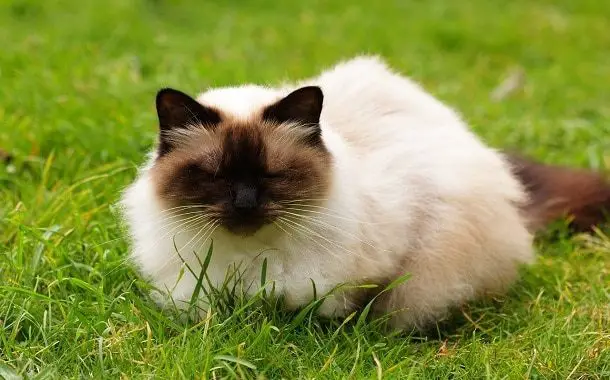How Much Does a Himalayan Cat Cost?
Last Updated on March 12, 2024
Written by CPA Alec Pow | Content Reviewed by ![]() CFA Alexander Popinker
CFA Alexander Popinker
With their striking blue eyes, long fluffy coats, and sweet personalities, it’s easy to understand the popularity of Himalayan cats as family pets. However, their desirable traits also make them one of the more expensive cat breeds to own. What should you budget for if you’re considering adding a Himalayan cat to your home?
In this article, we’ll break down the various expenses involved in Himalayan cat ownership, from the initial purchase price to ongoing care, medical costs, supplies, and other considerations that impact your budget. With realistic insight into the costs, you can make an informed decision when preparing for this affectionate and beautiful breed.
How Much Does a Himalayan Cat Cost?
The typical purchase price range to buy a Himalayan kitten or cat from a quality show breeder is $800 to $2,000+.
Given their status as pedigreed show cats, Himalayan kittens, and cats are most often sourced directly from specialized reputable breeders rather than through pet stores. Specific cost considerations include:
- Age – Pedigreed kittens usually command the highest pricing at $1,200 to $2,500+, while retired adult breeders often cost less.
- “Breeder of merit” status – Accomplished breeders can charge premium rates for their champion bloodline litters.
- Rare point coat colors – Specialty colors like chocolate, lilac, and blue point can fetch higher pricing, from $1,500 to $3,500+.
- Pedigreed lineage – Kittens from long lines of award-winning champion show parents or grandparents often cost $2,000+.
- Registration – CFA registered breeding/show cat stock is more valuable than unregistered pets.
- Location – Prices trend higher in competitive urban markets supply vs. demand.
When purchasing a Himalayan kitten, expect health guarantees, support, and continued breeding mentorship from an ethical, responsible breeder. Avoid “backyard breeders” just out for profit.
On the Cat Breeds List, Himalayan kittens (pet quality) are reported to cost between $800 and $1,500, with an average price range of $1,000 to $2,500. Himalayans from reputable breeders with desirable color and proportion can cost between $1,800 and $3,500.
Hepper notes that the cost of a Himalayan cat is between $750-$1,500, and the initial setup and supplies can range from $700 to $1,000, including expenses like the first vet visit, vaccinations, collar, toys, scratch pads, litter box, and more.
Monthly costs for caring for a Himalayan cat can vary from $110 to $300, covering expenses like food, grooming, medications, and vet visits.
According to Brownsburg Animal Clinic Himalayan cats are listed among the least expensive cat breeds with an estimated purchase price ranging from $300 to $500.
Adoption Fees for Rescue Himalayans
For those open to adopting and offering an existing cat in need a loving forever home rather than buying a kitten, breed-specific Himalayan cat rescues and shelters typically charge adoption fees in the range of $75 to $200.
While the upfront cost of adopting a rescue Himalayan is notably more affordable than purchasing from a breeder, the trade-off is often less certainty regarding the cat’s background and pre-adoption experiences. Most rescues will health screen cats and kittens prior to adoption to help match you with the right personality and care needs.
An Overview of the Himalayan Cat Breed
First, let’s look at what makes Himalayans unique:
- Their lavish, long-haired coats showcase distinctive “point” markings with darker coloration on the face, ears, legs and tail overlaying a white or ivory base fur.
- Striking, vivid deep blue eye color is a signature trait resulting from the color point gene also found in Siamese cats.
- Originated by crossing the Persian cat with Siamese to introduce the color point markings into Persian bloodlines.
- Recognized as a distinct pedigreed breed with championship status by major cat registries like CFA, TICA, and FIFE.
- Typically have calm, trusting, people-oriented personalities – Himalayans love laps and affection from their humans.
It’s their unique appearance and sweet disposition that help make Himalayans one of the world’s most beloved and coveted feline breeds among cat lovers globally.
Typical Ongoing Care and Medical Expenses
In addition to the initial purchase costs, Himalayan ownership involves regular expenses:
- Food– Quality cat food, $20-$50 monthly
- Grooming– Brushing, nail trims, bathing, $50-$100 monthly
- Veterinary– Annual check-ups, vaccinations, $200-$400 yearly
- Medical treatment– For injuries or illness, budget $500-$2,000+
- Pet insurance– $100-$300 monthly for emergency coverage
Annual pet care costs often total $1,000-$2,000 or more per cat. Proper preventative care is crucial for this breed.
You might also like our articles about the cost of a Norwegian Forest Cat, Savannah Cat, or Cheetoh Cat.
In addition to the initial costs of acquiring your Himalayan through purchase or adoption, responsible cat ownership also involves regular ongoing expenses for:
- High quality food– Expect to spend $20 to $50+ monthly for top-grade cat foods formulated for health and to reduce hairballs. Treats and supplements add more.
- Grooming needs– With daily brushing, occasional baths, nail trims, teeth cleanings, detangling, etc. budget approximately $50 to $100 monthly for their intensive coat maintenance. Professional groomers may be needed.
- Routine veterinary care– Annual wellness exams, standard vaccinations, and lab work often totals $200-$400 annually. Dental cleanings and emergency vet buffer add more.
- Medical treatment– For injuries, illnesses, or hereditary conditions often seen in the breed, you must financially prepare for expenses potentially reaching $500-$2,000+.
- Pet insurance– $100-$300 monthly for emergency coverage
All said, expected annual pet care costs often range $1,000-$2,000 + per Himalayan cat, highlighting the need for diligent preventative care with this pedigree.
Additional Supplies and Accessories Costs
In addition to the day-to-day care costs above, you’ll need to outfit your home and stock up on supplies to welcome your Himalayan cat:
- Premium clumping litter and boxes – $50 initially, then $20 monthly
- Scratching posts and climbable cat trees – $50 to $150 each
- Assortment of interactive toys – $50 initially, then $10 to $20 monthly for replacements
- Ceramic food and water bowls – $20 to $50
- Plush designer cat beds and blankies – $50 to $200+
- Brushes, combs, clippers, shampoo, dental supplies – $100 to $300+ initially
Factor another $500-$1,000+ in initial supplies and accessories costs, plus $100+ monthly in recurring expenses to properly spoil your feline companion.
Long-Term Budgeting Factors
 With average healthy lifespans of 12 to 15+ years possible, welcoming a Himalayan cat into your family represents over a decade of commitment. Costs accumulate exponentially over time, further making pet health insurance helpful for mitigating expenses.
With average healthy lifespans of 12 to 15+ years possible, welcoming a Himalayan cat into your family represents over a decade of commitment. Costs accumulate exponentially over time, further making pet health insurance helpful for mitigating expenses.
Due to their grooming requirements and pedigree health risks, total yearly budgets of $2,000-$5,000 + are realistic for Himalayan cat owners when tallying up all care, food, medical, grooming, training, accessories, boarding, and incidental costs.
But devotees of the stunning and sociable Himalayan breed will tell you their companionship and joyful spirit are utterly priceless. With diligent planning and budgeting, Himalayan cat parenthood can absolutely be a manageable and immensely rewarding undertaking.
Cost-Saving Strategies
Here are a few tips for cost-conscious Himalayan owners to help control expenses without compromising their cat’s health and happiness:
- Take time to research and price compare high quality cat food options and buy in bulk on sale when possible.
- Invest in grooming tools and dedicate time to brushing, combing, and bathing at home to reduce professional groomer visits.
- Make DIY cat toys and climbing trees rather than buying premium products. Rotate store-bought toys to keep them novel.
- Grow cat grass and catnip to supplement store-bought treats and appeal to their natural instincts.
- Choose monthly flea/tick and heartworm medications wisely – generic options work as well as name brands for less.
- Negotiate discounts for bundled veterinary services like annual checkups and dental cleanings.
Conclusion
From their stunning coat colors to affectionate personalities, it’s easy to be charmed by the Himalayan breed. But with higher purchase prices and intensive grooming needs, they represent a serious commitment in time, effort, and expense compared to many other cats.
By understanding the costs involved and budgeting diligently for their specialized care, Himalayan enthusiasts agree the rewards of sharing your life with one of these magnificent felines far outweighs the investment. Do your homework, ask questions, enjoy the journey, and your new Himalayan friend will pay you back infinitely in love and companionship.
FAQs
What do you need to know about Himalayan cats?
Do extensive research on their care needs, purchase from an ethical responsible breeder, budget for significant expenses, prepare your home, commit to a 10–15-year relationship, and give them lots of affection! This high-maintenance breed thrives on attention.
What do Himalayan cats like to play with?
Himalayans love interactive wand toys allowing them to channel their hunting instincts, puzzle feeders with treats, catnip stuffed mice or balls, crinkle balls, scratching posts, perches, climbing cat trees, and anything sparkly or feathery! Routinely rotate toys to prevent boredom.
Are Himalayan cats hard to take care of?
Definitely – daily grooming is essential given their long silky coats prone to tangles and matting. Their stunning coats also require vigilance to prevent skin irritation, fleas, and other issues. Plus, they crave lots of attention. Overall Himalayans have greater care needs than many breeds.
Do Himalayan cats have health problems?
Potential concerns include dental disease, respiratory issues, eye abnormalities, kidney disease, heart conditions, difficulty breathing for flat-faced Persians, and predispositions for certain cancers. Research breed-specific conditions, budget for quality care, and invest in pet insurance.


Leave a Reply
Want to join the discussion?Feel free to contribute!